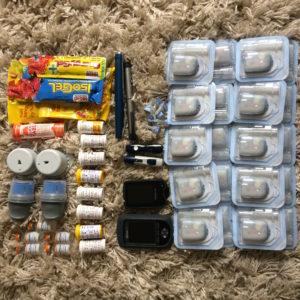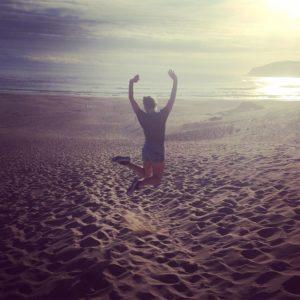Thanks to Jen Grieves for sharing her travel exploits with us.
 “Earlier this year I was lucky enough to head to South Africa for work for a month (I know, tough gig…) I couldn’t resist the opportunity to add a few weeks onto the end to explore this fascinating country. But in 22 years of living with Type 1 diabetes, this would mark my first proper stint as a backpacker. Which gave me a lot to think about, not least because I didn’t even own a backpack when I booked my flights…
“Earlier this year I was lucky enough to head to South Africa for work for a month (I know, tough gig…) I couldn’t resist the opportunity to add a few weeks onto the end to explore this fascinating country. But in 22 years of living with Type 1 diabetes, this would mark my first proper stint as a backpacker. Which gave me a lot to think about, not least because I didn’t even own a backpack when I booked my flights…
Say yes, figure it all out later. This is generally my mantra for life, and it’s served me well for the most part. But WOW there’s a lot of figuring out to do to set off safely on a backpacking trip with a chronic condition. I’ve been fortunate to have had many mad, incredible and bizarre experiences in my life, but I’ve also made enough mistakes along the way to know that Type 1 diabetes is fine until it’s not fine, and I didn’t want ‘not fine’ to be hundreds of feet above sea level with only my echoing cries for company. Dramatic, much?
I will happily declare that I was incredibly nervous as I approached this trip. Travelling with Type 1 can seem daunting, and possibly even risky, but I’m here with my feet and my busted pancreas back in the UK, to say that it’s absolutely worth it.
In the moment
I hiked, canoed, swam and even paraglided my way across South Africa’s stunning Garden Route, and made memories that will stay with me for life. I met people from all over the world, sharing bedrooms with them as well as buses, bathrooms and oceans. I climbed mountains, witnessed breathtaking scenery and got close to elephants, lions and even a whale. Did I have hypos? Yes. Did I have to think about my diabetes? Of course, a lot of the time. But did it dictate my experience? Not in the slightest.
 What I learnt from this adventure was that it’s all in the planning. Allowing yourself adequate time to figure out what you need to take with you (and how you’re going to carry it) will make for a much smoother, less scary experience once you’re miles away from home and out of your comfort zone. I was adamant that I wanted to be fully immersed in all the incredible experiences as they happened, not feeling frantic about using up all my glucose strips. Thanks to a bit of diligent planning, my trip was about the adventure, not about my Type 1.
What I learnt from this adventure was that it’s all in the planning. Allowing yourself adequate time to figure out what you need to take with you (and how you’re going to carry it) will make for a much smoother, less scary experience once you’re miles away from home and out of your comfort zone. I was adamant that I wanted to be fully immersed in all the incredible experiences as they happened, not feeling frantic about using up all my glucose strips. Thanks to a bit of diligent planning, my trip was about the adventure, not about my Type 1.
I started making a list of everything I would need a couple of months ahead of my departure date, adding random things as and when I thought of them. I soon clocked that this was not a packing job I could leave until the last minute, as is my usual approach. I had to make an appointment with my GP, for instance, to ask for surplus supplies of test strips and insulin outside of my normal prescription. I ordered some Libre sensors, which took four weeks to arrive. The sheer quantity of Omnipods I had to carry with me was quite something. There were insulin vials, insulin cartridges, backup injections just in case, spare glucose meters, hypo fixes… all taking up precious room in my backpack that ideally would have allowed for extra dresses. But by removing a lot of the packaging, and stuffing test strips in shoes and socks, I saved a fair amount of space – and weight. Supplies and equipment are getting smaller and smaller, so lugging all my kit around was not as laboured as it would have been just a couple of decades ago.
Feeling secure
 Airport security I know makes a lot of people feel nervous. I thankfully have never had an issue here – airport staff sees all sorts of medical devices every single day. I always carry a doctor’s note outlining my condition and the supplies I need to carry, and if the scanner does go off when I walk through, I always flag that I have an insulin pump on before I get a closer inspection. Oh, I NEVER put my diabetes supplies in the hold – just in case my luggage goes walkies! Once I’ve landed however, I do split my supplies into different bags to make sure it can’t all get lost at once.
Airport security I know makes a lot of people feel nervous. I thankfully have never had an issue here – airport staff sees all sorts of medical devices every single day. I always carry a doctor’s note outlining my condition and the supplies I need to carry, and if the scanner does go off when I walk through, I always flag that I have an insulin pump on before I get a closer inspection. Oh, I NEVER put my diabetes supplies in the hold – just in case my luggage goes walkies! Once I’ve landed however, I do split my supplies into different bags to make sure it can’t all get lost at once.
Along the route, I kept my insulin in a Frio cooling wallet (a god-send in hot countries) and made sure that any supplies I didn’t take out on day trips were stored in a padlocked locker (most hostels offered these, but don’t forget to bring your own lock with you) rather than just loose in the backpack which was in the corner of the dorm.
I was incredibly conscious of always having a serious supply of glucose on me – both fast acting and more complex – so that I didn’t get caught out up a mountain, or in the middle of the ocean. Most days I had a backpack on me, so this wasn’t a problem, but for instance if you’re camping or trekking, it may be days before you can restock. With all that heat and activity your insulin requirements may change, which could lead to an increased number of hypos. Stuffing sweets into my mouth while sipping champagne on a sunset cruise was not my most dignified moment, but I’ll happily do it to get a hypo fixed quickly!
The biggest lesson I learnt was that for me, an active, outdoors and sea-soaked holiday (i.e. the type I ADORE) requires a lot more focus with an insulin pump than it ever did with injections. Sunscreen and sweat is powerful anti-adhesive combination when it comes to the patch pump. Likewise surfing, snorkelling and scuba diving are all very physical activities that made my insulin pump throw a tantrum on more than one occasion. There are some situations, it seems, that a pump is just not compatible with, so having not only a truckload of spares, but back-up injections with me, meant I could power through a surfing lesson and not freak out if my pod peeled off (or more likely, got attacked by a crashing wave…). A combination of diabetes tech and extra finger stick tests allowed me to keep a close eye on what my blood sugars were doing as my routine when out of the window and I just poured all my energy into trying to stay upright on a surfboard!
Future forward
I would still absolutely stick to my insulin pump for future travels, just because the control and precision it gives me far outweighs any extra hassle, but it’s certainly something to consider when packing those supplies. This is one instance where more is more!
 Time zones are another thing to think about when travelling, particularly if you’re going to multiple countries. When I first landed in South Africa, I blamed my tricksy blood glucose levels on the heat and the change in routine. But after a couple of days I realised I needed to change my basal rates to match the new time zone. Even two hours’ difference had a huge impact on my waking glucose. What I will say is that as I relaxed and my cortisol levels decreased, my insulin requirements dramatically dropped. Hormones are a rather spectacular entity!
Time zones are another thing to think about when travelling, particularly if you’re going to multiple countries. When I first landed in South Africa, I blamed my tricksy blood glucose levels on the heat and the change in routine. But after a couple of days I realised I needed to change my basal rates to match the new time zone. Even two hours’ difference had a huge impact on my waking glucose. What I will say is that as I relaxed and my cortisol levels decreased, my insulin requirements dramatically dropped. Hormones are a rather spectacular entity!
Food is a huge part of my life, and trying new cuisine is one of the best things about travel but I’d advise that you watch out for aeroplane food which can be full of hidden mysteries that can mess with your blood sugars. Eating out while travelling is a fantastic way to get to know people. I inevitably didn’t always get my carb portions right, but I never, ever gave myself a hard time about this – I just corrected as soon as possible and carried on regardless. Food is there to be enjoyed, especially on holiday!
There’s a lot of variable factors to contend with while backpacking so I think it’s important not to give yourself a hard time if things aren’t perfect. Luckily I’m a huge seafood fan, so a trip abroad often results in a low-carb diet by proxy, which helps to combat fluctuating glucose levels. Oysters, anyone? That being said, I had more than one incredible burger along the way…
I also believe that travelling is not a time to be shy about Type 1 diabetes. There’s no need for a fanfare, and it’s an incredibly personal condition, but I liked knowing that at least one person I was with knew what I was dealing with, even on the most basic level. I actually found it to be a great conversation starter, so own it, because you’re bossing it!
There are other easy hacks that are applicable to any kind of travel with Type 1, such as carrying a copy of your prescription with you, as well as your pump settings and ratios if you use one. Travel insurance is a must, and it’s helpful if someone back in the UK has a copy of all your documents.
Back pack backup
If you give it a bit of thought, there’s no reason why you can’t enjoy the trip of a lifetime with Type 1, backpack in tow. My diabetes certainly felt more present than it had done in a while, because so much of the norm had gone out of the window, but that also made the trip one of the most rewarding experiences of my life. Plan ahead and the biggest worry you’ll have is the thought of washing your pants in the sink. Again.
News items and features like this appear in the Desang Diabetes Magazine, our free-to-receive digital journal (see below). We cover diabetes news, diabetes management equipment (diabetes ‘kit’ such as insulin pumps and continuous glucose monitoring equipment) and news about food suitable for a diabetic diet including a regular Making Carbs Count column. We just need your email address to subscribe you (it’s free, and you can easily unsubscribe should you wish to).



